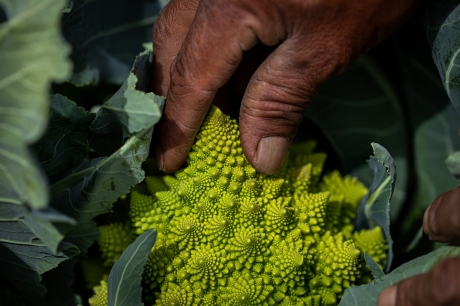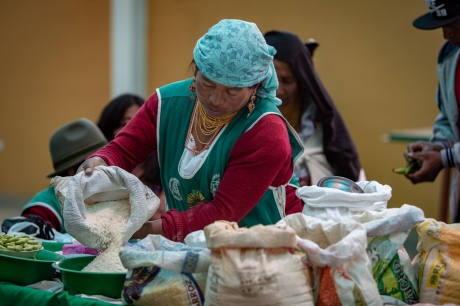
©FAO/Cristina Vega
To date, we have relied on a handful of crops, such as wheat, corn and rice, for most of our caloric needs, but there are more than 7,000 plant species, and perhaps up to 30,000, which are considered edible by humans.
So how much of an impact do climate change, conflicts, health considerations, lifestyle trends and other modern-day issues have on the crops we grow now and those we might need in the future?
These are among the issues addressed in a new report, The Plants That Feed The World, by the Food and Agriculture Organization of the United Nations (FAO).

The International Treaty on Plant Genetic Resources for Food and Agriculture, with its Secretariat based at FAO, was adopted in 2001 to ensure that the plant genetic resources most important to human diets were safeguarded and used equitably around the world. The Treaty’s goal is to ensure that plant genetic resources are accessible by everyone, especially farmers in developing countries so that we can all benefit from a diversity of crops that can meet our nutritional needs. Annex 1 of this legally binding agreement lists 64 of the key crops that make up our “food basket” and whose genetic resources are exchanged by gene banks through the International Treaty’s Multilateral System for Access and Benefit-sharing.
Most of us have our own ideas about the food and plants that make up a large part of our diet. But let’s look at four significant trends identified in the study that are shaping the way plants are feeding us and that demonstrate why genetic resources are so important for better production, nutrition, environment and livelihoods:
1. The concept of food security has expanded.
One reason our “food basket” will need to incorporate more plants than it used to is because our understanding of food security is evolving. More than 20 years ago, when the International Treaty was first drawn up, the emphasis was overwhelmingly on the calories needed to provide a basic diet and eradicate hunger. We now increasingly understand that the focus also needs to be on nutrition, delving into micro-nutrients as well as macronutrients.
In many countries, undernutrition and overnutrition coexist as diets undergo radical changes and processed products often supplant traditional foods. With the trends of overweight and obesity becoming as concerning as hunger, nutritious plants and not just caloric ones, need to be incorporated in our food basket.
2. The plants of the past are not necessarily the plants of the future.

As well as eating more vegetables, fruit, nuts and seeds because of nutrition concerns, there is a trend towards consuming more plant-based proteins, like pulses.
Lesser-known, nutritious cereals, such as millet and sorghum, or cereal-like, equally gluten-free alternatives, such as quinoa and amaranth, are also on the rise. Minor and underutilized crops like these are now at the forefront of food trends, not only from a nutrition perspective but also because many are environmentally beneficial.
3. Countries are becoming even more interdependent on each other for crop varieties.
With the climate crisis affecting global precipitation patterns and temperatures, certain varieties of crops are no longer growing well in places where they once thrived. For example, just a few years ago, perhaps not many people would have predicted that maize would become difficult to grow in some parts of Africa. Yet, farmers in these areas are now searching for other crops, like millets, that are more suitable to the reduced rainfall.
These changing weather patterns mean there will be more need for countries to obtain plant varieties from elsewhere in the world in order to continue or improve their production.
Climate change is only adding to the interdependence, but countries have always been reliant on one another for crops that originated elsewhere. For example, coffee varieties from Africa have travelled all over the world. While, in terms of potatoes, South America still has more varieties to offer than any other region.
In these contexts, FAO feels that the International Treaty’s multilateral approach to collaboration between countries is ever more important.
4. Tastes and fashions are also changing the demand for crops.

Changing tastes and trends are also spurring demand for new crop varieties from farmers seeking to improve their livelihoods, whether it’s by growing quinoa or by cultivating pigeon peas.
But new demands are also coming from other quarters, such as chefs who are keen to explore the tastes and textures of traditional, and often more sustainable, grains. For example, Sierra Leonean chef, Fatmata Binta, has made it a point in her cooking to highlight fonio millets, which require less water and are very nutritious.
These voices were not a part of the discussions when the International Treaty was first negotiated, but they are now increasingly making themselves heard.
As the only binding international agreement dedicated to safeguarding, conserving and exchanging the genetic diversity of the plants that we farm and eat around the world, the International Treaty has an increasingly important role in our interdependent and changing world.
The new report, which brings together data for 355 crops, will play a key part in informing policy discussions, including updating the basket of crops in the International Treaty’s Annex I. With the massive amount of publicly available data underlying the study, it will also provide a key resource for researchers and decision-makers globally. The report lays the foundation for allowing humankind to explore the potential of thousands of more plants to meet our food needs into the future.
Source: the FAO News and Media office, Rome
– global bihari bureau






Great post, you have pointed out some wonderful points, I too conceive this s a very excellent website.